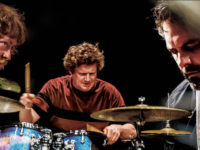by Mark Saleski
In his essay, “Listening To Music,” composer John Cage offers a possible definition of music and a framework for its evaluation: “I have talked with several musicians who have seriously claimed that music is not made of sound, but rather of the relationships of the sounds, and that in order to appreciate it we must understand its structure.” The implication is that only the trained musician (or person well-versed in music theory) can properly decide what is “good.”
As you would expect, Cage went on, in his usual concise fashion, to pick apart this idea. My favorite bit was his attempt to turn the issue on its head by an application to the visual arts: “… it would seem logical to expect that painting is not made of color and shape.”
Cage’s musical conceptions can force a person to consider alternate approaches to the question “What is music?” More than that, why does an individual enjoy a particular sound, texture, or combination of sounds? This is a good thing. While we all have our preferences, it can be refreshing to discover something that pushes open the mind’s ear.
Sometimes, it’s a gentle push. Gordon Grdina takes the “normal” (as if Gary Peacock and Paul Motian might ever be described in that way) guitar-based jazz trio and moves it in a slightly different direction by at times replacing the guitar with the fretless, Middle Eastern oud. The results are both subtle and stunning.
Grdina’s guitar lines, clean of tone with hint of a Jim Hall-ish angularity, are very much at home in the bed put together by Peacock’s very woody bass and Motian’s versatile kit work. The opening “Yellow Spot Into The Sun” shows a trio of musicians very comfortable with each other: When Peacock takes a solo and Grdina and Motian drop into the comping role, it’s evident that some higher level communication is going on.
In this trio’s traditional configuration, Grdina also reminds me of Bern Nix from Ornette Coleman’s electric phase. It’s interesting how that approach is reflected when the switch is made to the oud. “Renunciation” begins with a long, freely improvised section before moving into a more classical Arabic-sounding resolution. This reveals not only the malleability of this group but some common ground between the musics in question.
As Grdina’s trio moves between these two genres, the ear is presented with a mix of the straight ahead (“Albert The Monk”), Arabic classical (the beautiful title track), and the more out-there (“String Quartet #6”). It’s quite amazing to hear how natural all of these styles feel when presented together.
John Cage was right. It’s not necessary to have inner knowledge of this (or any!) music to appreciate it. One listen to Think Like The Waves and you’ll just know.
[amazon_enhanced asin=”B000GCG5GU” container=”” container_class=”” price=”All” background_color=”FFFFFF” link_color=”000000″ text_color=”0000FF” /] [amazon_enhanced asin=”B002JIH8JC” container=”” container_class=”” price=”All” background_color=”FFFFFF” link_color=”000000″ text_color=”0000FF” /] [amazon_enhanced asin=”B002C7489S” container=”” container_class=”” price=”All” background_color=”FFFFFF” link_color=”000000″ text_color=”0000FF” /] [amazon_enhanced asin=”B000XVMAWW” container=”” container_class=”” price=”All” background_color=”FFFFFF” link_color=”000000″ text_color=”0000FF” /] [amazon_enhanced asin=”B003ZGV4QK” container=”” container_class=”” price=”All” background_color=”FFFFFF” link_color=”000000″ text_color=”0000FF” /]
- Why the Rolling Stones’ Harrowing ‘Gimme Shelter’ is Still Revealing New Depths - November 18, 2024
- How Talking Heads’ ‘Fear of Music’ Opened Up a World of Art and Sound - August 5, 2024
- How Deep Cuts Propelled Bruce Springsteen’s ‘Born in the U.S.A.’ - June 4, 2024




